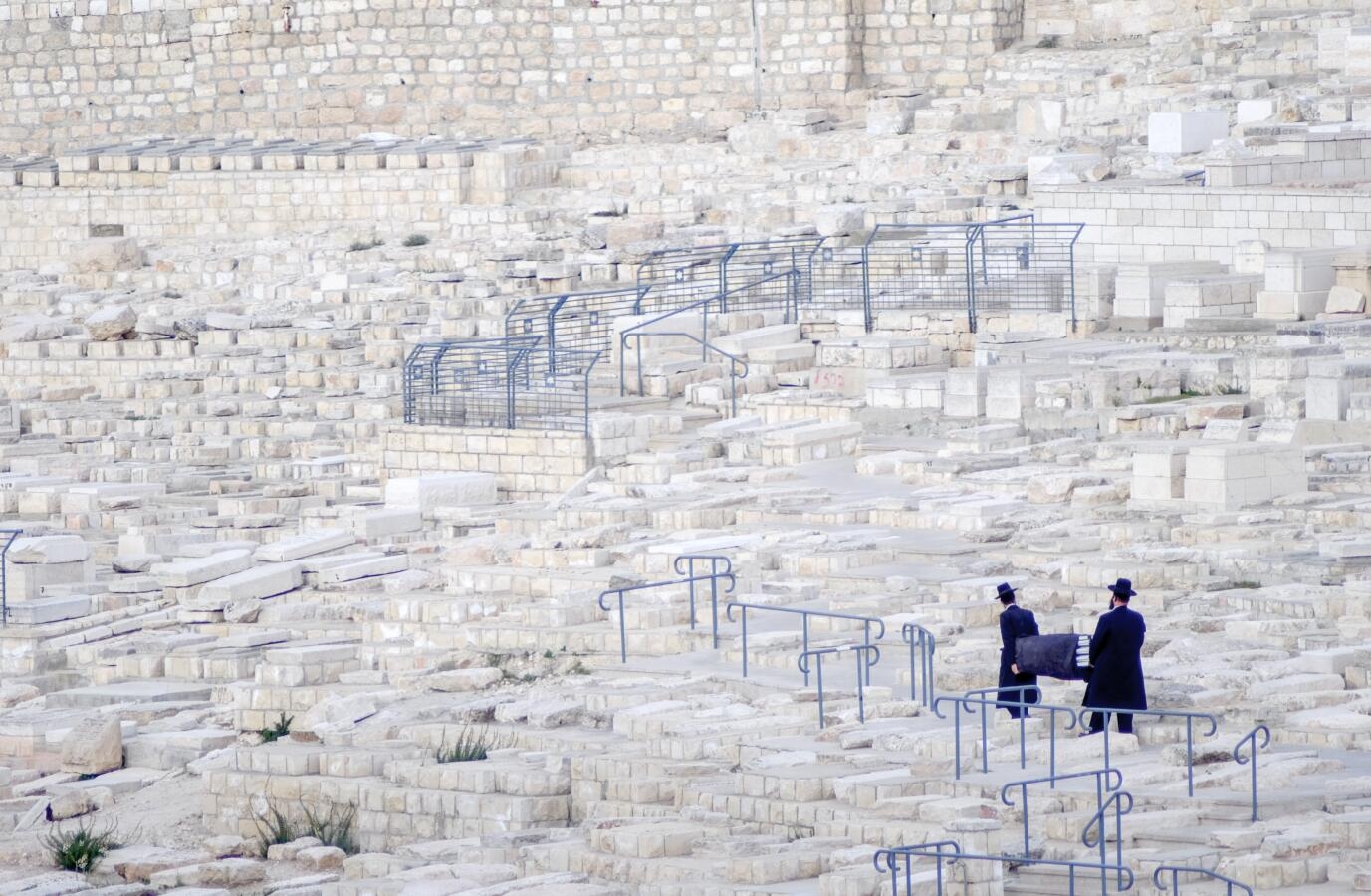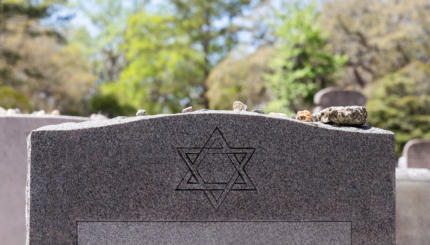Jewish funerals typically feature a range of customs. Below are some common questions about the rituals of Jewish burial.
Must I shovel dirt into the grave?
This is a common tradition that helps bring closure to the funeral. However, others feel the custom is potentially psychologically troublesome. The placing of earth on the casket or in the grave is a matter of personal choice.
Where is the torn garment worn?
Traditionally, the kriah [tearing] is made on the left side of the garment for parents (over the heart) and on the right side for other relatives. You may choose to have a tie, blouse or shirt, or suit lapel torn, or a black ribbon worn on a garment.
How long do I wear the kriah garment?
The tradition calls for the mourner to wear a torn garment during the shiva [first seven days of intensive mourning]. On Shabbat, Holy Days, and festivals, no public signs of mourning are worn.
With your help, My Jewish Learning can provide endless opportunities for learning, connection and discovery.
What about flowers at a funeral?
Although descriptions of flowers at funerals are found in the Talmud, most rabbis discourage the use of floral decorations at the funeral or on the casket on the grounds that the money spent on such displays is wasted. Instead, sympathizers are encouraged to send donations to favorite charities or to a charity specified by the bereaved family in the obituary notice. These charities will let the mourners know of your donation, a more appropriate way to express your solidarity with the family. If flowers are sent, you might suggest to the funeral director that they be donated to a hospital or nursing home after the service. In another reflection of differing burial customs, flowers are common at funerals in Israel.
I’ve seen the coffin covered with a cloth during the service. What’s that?
At some funerals, a large cloth, similar to the kind of cloth used to cover the lectern on a synagogue pulpit, is placed over the coffin. At Valley Beth Shalom, this cloth, called a miktze, is used at funerals of members. It is embroidered with the Hebrew words tzedakah tatzeel mimavet (“charity redeems from death”). The cloth remains on the coffin from the beginning of the service until it is lowered into the grave.
Why is the coffin not opened for viewing at Jewish funerals?
One of the major goals of Jewish funeral and mourning rituals is to solidify memories of the dead in the minds and hearts of the living. We hope to remember them as they were in the fullness of their lives–vigorous, hearty, beautiful–not as they often are at the end of their lives: weak, frail, helpless. Traditional Judaism argues against embalming or performing cosmetic surgery on the body. The deceased is not dressed in the finest of clothes. The Jewish way is to let the photographic image of the best of times be forever blazoned in the memory.
[A related comment by] Harold Schulweis: One of the most commonly asked questions is about the permissibility of a public viewing of the deceased. They claim to have seen it even at Jewish funerals. I explain that the Jewish tradition is sensitive to the status of the deceased. The deceased is a mirch v’ayns roch, someone who is seen but who cannot see. To open the casket and allow people to look at the deceased is to turn the comforters into spectators and the deceased into an “it.” We remember those we loved when they were free and active human beings, not as objects to be observed. Rarely, after the explanation of the ritual tradition, have the mourners objected to the practice.
Isn’t it true that sometimes mourners are asked to identify the body in the casket before burial?
Yes, especially if the body had not been positively identified before preparation for burial. In the past, most people died at home, surrounded by loved ones. Today, most people die in hospital rooms with family members scattered in many different places. Thus, in some communities, the request to “view” the deceased has become more common. This viewing of the deceased is strictly reserved for the immediate mourners, not the assembled friends and family. For some, this encounter is a comforting final good-bye and a chance to see the beloved at peace. For others, the idea of looking into a coffin is not comforting at all.
Is it possible to bury personal items with the body?
According to Jewish law, each person receives equal burial and there is no need for physical items to be buried with the deceased. Some people request that a small memento be placed in the casket.
What about earth from the land of Israel?
An age-old wish among Jews in the Diaspora during the past 2,000 years of dispersion was to be buried in the hallowed ground of Eretz Yisrael [the land of Israel]. For those not able to be buried there, a bit of earth from the land of Israel can be placed in the coffin. Some families actually gather a sack-full of earth from Israel especially for this purpose. One of the most moving experiences I have had on my many trips to Israel was the time Susie and I collected such a sack of dirt at the same time we planted trees. We brought some of it to Omaha to place on the grave of Susie’s mother, who had died the year before. You might also ask the funeral director if some dirt from the Holy Land is available.
I see people walking on graves to get to graveside services. Is that proper?
People should not step on graves as a matter of respect. In some cemeteries, walkways are provided for visitors to avoid inadvertently stepping on a grave. However, the need for maximum use of space in some cemeteries creates a situation when walking on a grave is unavoidable. Jewish law was sensitive to this and allows stepping on a grave if there is no other way to reach another gravesite.
Why can’t a kohen attend a funeral?
Those Jews who trace their ancestry back to Aaron, the first Jewish priest (kohen), brother of Moses, traditionally did not come into contact with any dead body. In the Israelite religion, such contact rendered the priests “impure” and disqualified them from their priestly duties. To this day in traditional practice, kohanim do not enter a funeral home or a cemetery in order to avoid being in proximity to the dead. Of course, exceptions are made when the kohen must bury one of the seven immediate relatives. Many Jews who are kohanim will attend a funeral; others will enter a cemetery but will not come close to the grave. In any of these cases, you may attend a funeral where some Jews stand just outside the chapel. They are most likely kohanim.
How do I let my friends know that donations to a favorite charity in memory of the deceased would be appreciated?
There are three ways to get this information to the community:
1) a line in the obituary,
2) an announcement during the funeral service, or
3) a card containing this request given to attendees at the funeral.
Reprinted with permission from A Time to Mourn, A Time to Comfort (Jewish Lights).
Sign up for a Journey Through Grief & Mourning: Whether you have lost a loved one recently or just want to learn the basics of Jewish mourning rituals, this 8-part email series will guide you through everything you need to know and help you feel supported and comforted at a difficult time.
Looking for a way to say Mourner’s Kaddish in a minyan? My Jewish Learning’s daily online minyan gives mourners and others an opportunity to say Kaddish in community and learn from leading rabbis.
kohen
Pronounced koe-HAIN, also KOE-hen, Origin: Hebrew, a descendant of the sons of Aaron who served as priests in the Temple in Jerusalem.
kriah
Pronounced: KREE-yuh, Origin: Hebrew, Jewish mourning custom of tearing one's garment.



